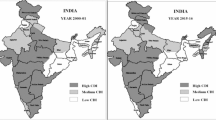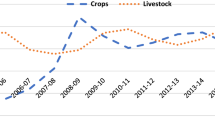Abstract
This paper focuses on trend in India’s agricultural growth estimated based on structural breaks in agricultural GDP from 1981–82 to 2019–20, using Bai–Perron multiple breakpoint method. The paper also examines the relationship between agricultural growth and crop diversification. At the national level, five structural breaks in agricultural GDP were identified: 1987–88, 1992–93, 1997–98, 2003–04, and 2011–12. At the state level, structural break points occurred at different time periods indicating the effect of state-specific policy changes or occurrence of extreme climatic events. The southern, western, and central regions have highly diversified cropping pattern, whereas eastern and northern regions follow a specialised cropping pattern. Panel instrumental variable regression results show that crop diversification has a positive and statistically significant effect on agricultural output controlling for effects of other variables such as gross terms of trade, irrigation, cropping intensity, public capital expenditure, fertiliser use and labour. The study results have policy implications for promoting crop diversification that holds the key to sustain agricultural growth in the long run.

Similar content being viewed by others
Notes
See Kurosaki (2003) for a long-term analysis of crop diversification and agricultural growth in West Punjab from 1903 to 1992.
According to Kurosaki (2003), CDI has the intuitive meaning of the probability of hitting different crop if two points are randomly chosen from the whole area under cultivation in a state/district. Besides Herfindahl–Hirschman index, there are other alternative measures used for computing the level of crop diversification (for details see, Shiyani and Pandya 1998; Chand 1999). Conceptual definition and approaches on diversification in agriculture can be found in Vyas (1996) and Chand (1999). Although many studies have considered proportion of area under individual crops in total cropped area (i.e. shift in area from one crop to another crop) as a measure of crop diversification, role of price in influencing the decision of farmers for a shift in cropping pattern can be incorporated in the crop diversification index. The modified index can be written as, CDI* \(=1-\sum_{i=1}^{n}({Q}_{i}{P}_{i}/\sum_{i=1}^{n}{Q}_{i}{P}_{i})\) 2, where Q is i th crop output and p is price of ith crop output.
In this study, Eq. (5) is estimated as a production function. We acknowledge the limitation of the current approach as there could be a theoretical linkage between road density and agricultural output.
The entire analysis of performance of agriculture relates to GDP from agriculture (crop) sector. The output from the allied sector is not taken into consideration.
There is a broad consensus among various studies that there were four major national-scale meteorological drought events that took place between 1980 and 2020, namely in 1987, 2002, 2009, and 2012 (Udmale et. al., 2020, Kumar et. al., 2013). India witnessed one of the major national-scale meteorological drought events during 1987.
References
Acharya SP, Basavaraja H, Kunnal LB, Mahajanashetti SB, Bhat AR (2011) Crop diversification in Karnataka: an economic analysis. Agric Econ Res Rev 24(2):351–358
Ahluwalia MS (2000) India’s Economic Reforms: An Appraisal. In: Sachs J, Bajpa N (eds) India in the Era of Economic Reform. Oxford University Press, New Delhi
Akber N, Paltasingh KR (2019) Is Public investment complimentary to private investment in Indian agriculture? Evidence from NARDL approach. Agric Econ 50:643–655
Antoshin S, Berg A and Souto M. (2008), Testing for structural breaks in small samples, IMF working paper WP/08/75, international monetary fund, Washington, D.C.
Bai J (1994) Least squares estimation of a shift in linear processes. J Time Ser Anal 15(5):453–472
Bai J, Perron P (1998) Estimating and testing linear models with multiple structural changes. Econometrica 66(1):47–78
Bai J, Perron P (2006) Multiple Structural Change Models: A Simulation Analysis. In: Theory E, Practice: Frontier of Analysis and Applied Research (Essays in Honor of Peter Phillips), (eds) Corbae D. Hansen, Cambridge University Press, S. Durlauf and B.E
Bai, J. and P. Perron (2003),Computation and analysis of multiple structural change models. J Appl Econ”, 18(1): 1–22.
Balakrishnan P, Parameswaran M (2007) Understanding economic growth in India: a prerequisite. Econ Pol Wkly 42(27&28):2915–2922
Basavaraj ND, Gajanana TM, Satishkumar M (2016) Crop diversification in Gadag District of Karnataka. Agric Econ Res Rev 29(1):151–158
Behera UK, Sharma AR, Mahapatra IC (2007) Crop diversification for efficient resource management in India: problems, prospects and policy. J Sustain Agric 30(3):97–127
Bellon MR, Kotu BH, Azzarri C, Caraccicola F (2020) To diversify or not to diversify, that is the question pursuing agriculturaldevelopment for smallholder farmers in marginal areas of Ghana. World Dev. https://doi.org/10.1016/j.worlddev.2019.104682
Bhalla GS (2007) Indian Agriculture Since Independence. Sage Publications, New Delhi
Bhalla GS, Singh G (2001) Indian agriculture: four decades of development. Sage Publications, New Delhi
Bhalla GS, Singh G (2009) Economic liberalisation and Indian agriculture: a statewise analysis. Econ Pol Wkly 44(52):34–44
Binswanger HP, Khandler SR, Rosenzweig MR (1993) How infrastructure and financial institutions affect agricultural output and investment in India. J Dev Econ 41:337–366
Birthal PS, Roy D, Negi DS (2015) Assessing the impact of crop diversification on farm poverty in India. World Dev 72:70–92
Birthal PS, PK Joshi, D Roy and A Thorat (2007), Diversification in Indian agriculture towards high-value crops: The Role of Smallholders”, IFPRI Discussion Paper 727,Internatioanl Food Policy Research Institute (IFPRI), Washington, D.C.
Casini A, and Perron P. (2019), Structural Breaks in Time Series. Oxford Research Encyclopedia of Economics and Finance. Retrieved 31 Oct. 2023, from https://oxfordre.com/economics/view/https://doi.org/10.1093/acrefore/9780190625979.001.0001/acrefore-9780190625979-e-179.
Chand R (1996) Diversification through high value crops in Western Himalayan region: evidence from Himachal Pradesh. Indian J Agri Econ 51(4):652–663
Chand R (1999) Agricultural diversification in india: potentials and prospects in developed region. Mittan Publication, New Delhi
Chand R, Parapparathu S (2012) Temporal and spatial variations in agricultural growth and its determinants. Econ Pol Wkly 47(26&27):55–64
Chand R, Raju SS, Pandey LM (2007) Growth crisis in agriculture: severity and options at national and state levels. Econ Pol Wkly 42(26):2528–2533
Chand R, Raju SS, Pandey LM (2010) Effect of global recession on Indian agriculture. Indian J Agri Econ 65(3):487–496
Dasgupta S, Bhaumik SK. (2014), Crop diversification and agricultural growth in West Bengal. Indian Journal of Agricultural Economics, 69(902–2016–67970), 108–124.
De Janvry A (2010) Agriculture for development: new paradigm and options for success. Agric Econ 41(S1):17–36
Deokar BK, Shetty SL (2014) Growth in Indian agriculture: responding to policy initiatives since 2004–05. Econ Political Weekly 49(26):101–104
Deshpande RS, Arora S (2010) Agrarian Crisis and Farmer Suicide. Sage Publications, New Delhi, Edited
Feliciano D (2019) A review on the contribution of crop diversification to sustainable development goal 1 “no poverty” in different world regions. Sustain Dev 27:795–808
Ghosh M (2002) Trends, random walks and structural breaks in Indian agriculture. Indian J Agri Econ 57(4):679–697
Ghosh M (2008) Economic Reforms and Indian Economic Development. Bookwell, Delhi
Ghosh M (2010) Structural Breaks and Performance in Indian Agriculture. Indian Journal of Agricultural Economics 65(1):59–79
Gulati A, Fan S (2007) The dragon and the elephant: Agricultural and rural reforms in China and India. International Food Policy Res Institute, Washington, D.C.
Hazell, PBR (200). The Asian green revolution, IFPRI Discussion Paper 00911, International Food Policy Research Institute (IFPRI), Washington, D.C.
Hazra CR (2001) Crop Diversification in India. In: Papademetriou MK, Dent FJ (eds) (2001), Crop diversification in the Asia-Pacific Region, Food and Agriculture Organization ofthe United Nations. Regional Office for Asiaand the Pacific, Bangkok, Thailand
Jana A, Chattopadhyay A (2023) Drought and Socioeconomic Drivers of Crop Diversity in India: A Panel Analysis. Agri Res 12(4):450–461
Joshi PK, Gulati A, Birthaland Tewari PS, L. (2004) Agriculture diversification in South Asia: patterns, determinants and policy implications. Econ Pol Wkly 39(24):2457–2467
Joshi, P. K.; Birthal, P. S. and Minot, N. (2006), Sources of agricultural growth in India: Role of diversification towards high-value crops. MTID Discussion Paper No. 98, Markets, Trade and Institutions Division, International Food Policy Research Institute, Washington, D.C.
Kannan E (2011) Trends in India’s agricultural growth and its determinants. Asian J Agri Dev 8(2):79–99
Kumar A, Kumar P, Sharma AN (2012) Crop diversification in Eastern India: Status and determinants. Indian J Agri Econ 67(4):1–17
Kumar KN, Rajeevan M, Pai D, Srivastava AK, Preethi B, B, (2013) “On the observed variability of monsoon droughts over India. Weather Climate Extremes 1:42–50
Kurosaki T (2003) Specialization and diversification in agricultural transformation: the case of West Punjab, 1903–92. Am J Agr Econ 85(2):372–386
Mellor JW (2017) Agricultural development and economic transformation: promoting growth with poverty reduction. Palgrave Macmillan
Mishra A, Kumar A, Johsi PK (2020) Transforming Agriculture in South Asia: The Role of Value Chains and Contract Farming. Edited, Routledge, London
Patnaik U (2005). Theorizing food security and poverty. Public Lect Deliv at IIC, Delhi, mimeo.
Perron P (2006), Dealing with structural breaks. in: Patterson K. Mills T.C. Palgrave Handbook of Econometrics, Palgrave-Macmillan, 278–352
Pingali PL (2012) Green revolution: impacts, limits, and the path ahead. Proc Natl Acad Sci 109(31):12302–12308
Rao PP, Birthal PS, Joshi PK, Kar D (2004), “Agricultural Diversification in India and Role of Urbanization, MTID Discussion Paper No. 77, International Food Policy Research Institute, Washington, D.C.
Rao PP, Joshi PK, Kumar S and Ganguly K (2008). Agricultural Diversification in Andhra Pradesh, India: Patterns, Determinants and Implications. In: Research Report No 2 International Food Policy Research Institute, IFPRI and International Crops Research Institute for the Semi-Arid Tropics, Andhra Pradesh, India
Reddy DN and S Mishra (2010), Agriculture in the Reforms Regime. IN: DN Reddy and S Mishra (Eds.) (2010), Agrarian Crisis in India, Oxford University Press, New Delhi.
Reddy DN, Mishra S (2009) Agrarian Crisis in India, Edited. Oxford University Press, New Delhi
Sathe D (1998) Asian currency crisis and Indian economy. Econ Pol Wkly 33(18):1003–1005
Sharma HR (2023) Patterns, sources and determinants of agricultural growth in India. Indian J Agri Econ 78(1):26–70
Shiyani RL, Pandya HR (1998) Diversification of agriculture in Gujarat. Indian J Agri Econ 53(4):627–639
Singh RB (2000) Environmental consequences of agricultural development: a case study from the Green Revolution state of Haryana, India. Agr Ecosyst Environ 82(1–3):97–103
Singh S, Singh M (2018) Dynamics of cropping pattern and diversification in Rajasthan during post-liberalisation period. Annals of the RGA 34(1):1–14
Singh P, Adhale P, Guleria A, Bhoi PB, Bhoi AK, Bacco M, Barsocchi P (2022) Crop diversification in South Asia: a panel regression approach. Sustainability 14(15):9363
Thorat S, Fan S (2007), Public investment and poverty reduction: lessons from China and India”, Econom Politic Weekly, 704–710.
Udmale P, Ichikawa Y, Ning S, Shrestha S, Pal I (2020) A statistical approach towards defining national-scale meteorological droughts in India using crop data. Environ Res Lett 15(9):094090
Vaidyanathan A (2010) Agricultural Growth in India: Role of Technology. Oxford University Press, New Delhi, Incentives and Institution
Vyas VS (1996) Diversification in agriculture: concept, rationale and approaches. Indian J Agri Econom 51(4):638–643
Acknowledgements
Authors sincerely thank three anonymous referees for their insightful comments, which helped to revise the paper substantially. Authors are also thankful to the Editors of this journal for their constructive suggestions.
Funding
Authors declare no funds or grants received for conducting this study.
Author information
Authors and Affiliations
Corresponding author
Ethics declarations
Conflict of interest
Authors have no competing interests to declare that are relevant to the contents of this article. As this article uses data that are available in public domain, there are no ethical issues involved in data compilation and hence approval from the institutional ethics review board was not required.
Additional information
Publisher's Note
Springer Nature remains neutral with regard to jurisdictional claims in published maps and institutional affiliations.
Rights and permissions
Springer Nature or its licensor (e.g. a society or other partner) holds exclusive rights to this article under a publishing agreement with the author(s) or other rightsholder(s); author self-archiving of the accepted manuscript version of this article is solely governed by the terms of such publishing agreement and applicable law.
About this article
Cite this article
Gupta, N., Kannan, E. Agricultural growth and crop diversification in India: a state-level analysis. J. Soc. Econ. Dev. (2024). https://doi.org/10.1007/s40847-023-00311-7
Accepted:
Published:
DOI: https://doi.org/10.1007/s40847-023-00311-7




